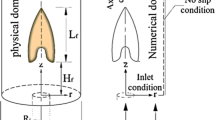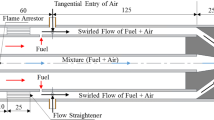Abstract
The flow, heat transfer and emissions features of a methane–air premixed impinging flame jet on an oval flat tube involving both smooth and concave surfaces are numerically investigated. The effects of important parameters such as Reynolds number (Re = 400, 800, 1200, 1600 and 2000) and nozzle-to-tube distance (H/D = 3, 5 and 8) on streamlines, pressure coefficient temperature field, surface heat flux, energy efficiency and pollutants formation are evaluated. Results reveal that at higher Reynolds number, a larger recirculation zone beyond the concave surface is generated, the flame direction becomes horizontal and maximum temperature is shifted far away from stagnation point. The highest value of pressure coefficient is found at Re = 400 occurring on stagnation point. Under constant Reynolds number, the maximum temperature value belongs to configuration with less H/D in which the thermal boundary layer becomes narrower. Except for Re = 2000, the highest heat flux values are associated with stagnation point, while a considerable off-stagnation heat flux is detected for Re = 2000. More amount of energy releases for less H/D at lower Reynolds number, while an inverse behavior is observed at higher ones. Simulations show that the best energy efficiency is found at Re = 400 and H/D = 3. The production of CO species is of high remarkable value at Re = 400 when the space between nozzle and tube is reduced. The highest value of NOx production is distinguished at the highest H/D and lowest Re (i.e., H/D = 8 and Re = 400), while the concentration of UHC remarkably increases with rising Reynolds number, especially for higher H/D.




























Similar content being viewed by others
Abbreviations
- c p :
-
Specific heat (kJ kg−1 K−1)
- C p :
-
Pressure coefficient
- D j,m :
-
Mass diffusion coefficient
- E :
-
Total energy (kJ kg−1)
- L :
-
Computational domain length (m)
- h :
-
Enthalpy (J kg−1)
- J :
-
Diffusion flux (kg m−2 s−1)
- k :
-
Thermal conductivity (W m−1 K−1)
- m :
-
Mass (kg)
- M :
-
Molecular weight (kg kmol−1)
- p :
-
Pressure (Pa)
- q″:
-
Heat flux (W m−2)
- Q w :
-
Total heat energy on wall (W)
- R j :
-
Production/consumption rate of the ith species (kg m−3 s−1)
- R ij :
-
Reaction rate (kmol m−3 s−1)
- Re:
-
Reynolds number
- s :
-
Curvilinear coordinate
- S h :
-
Volumetric heat source (kg m−4 s−1)
- T :
-
Temperature (K)
- V :
-
Velocity vector (m s−1)
- x, y :
-
Coordinate axes
- Y :
-
Mass fraction
- η :
-
Energy efficiency
- μ :
-
Dynamic viscosity (Pa s)
- ρ :
-
Density (kg m−3)
- f:
-
Fuel
- in:
-
Inlet
- j:
-
jth species
- CFD:
-
Computational fluid dynamics
- IFJ:
-
Impinging flame jet
- LHV:
-
Low heating value
- UHC:
-
Unburned hydrocarbon
References
Baukal CE Jr. Flame impingement, oxygen-enhanced combustion. Boca Raton: CRC Press; 2013. p. 261–98.
Dong LL, Leung CW, Cheung CS. Heat transfer from an impinging premixed butane/air slot flame jet. Int J Heat Mass Transf. 2002;45:979–92.
Dong LL, Leung CW, Cheung CS. Heat-transfer characteristics of a premixed butane/air flame jet impinging on an inclined flat-surface. Heat Mass Transf. 2002;39:19–26.
Dong LL, Leung CW, Cheung CS. Heat-transfer and wall-pressure characteristics of twin premixed butane/air flame jets. Int J Heat Mass Transf. 2004;47:489–500.
Shuhn-Shyurng H, Yung-Chang K. Effects of heating height on flame appearance, temperature field and efficiency of an impinging laminar-jet flame used in domestic gas-stoves. Energy Convers Manag. 2004;45:1583–9.
Kwok LC, Leung CW, Cheung CS. Heat-transfer characteristics of slot and round premixed impinging flame jets. Exp Heat Transf. 2003;16:111–37.
Chander S, Ray A. An experimental and numerical study of stagnation point heat transfer for methane/air laminar flame impinging on a flat surface. Int J Heat Mass Transf. 2008;51:3595–607.
Chander S, Ray A. Experimental and numerical study on the occurrence of off-stagnation peak in heat flux for laminar methane/air flame impinging on a flat surface. Int J Heat Mass Transf. 2011;54:1179–86.
Remie MJ, Särner G, Cremers MFG, Omrane A, Schreel KRAM, Aldén LEM. Heat-transfer distribution for an impinging laminar flame jet to a flat plate. Int J Heat Mass Transf. 2008;51:3144–52.
Remie MJ, Cremers MFG, Schreel KRAM, de Goey LPH. Analysis of the heat transfer of an impinging laminar flame jet. Int J Heat Mass Transf. 2007;50:2816–27.
Zhao Z, Wong TT, Leung CW. Impinging premixed butane/air circular laminar flame jet–influence of impingement plate on heat transfer characteristics. Int J Heat Mass Transf. 2004;47:5021–31.
Hustad E, Sonju OK. Heat transfer to pipes submerged in turbulent jet diffusion flames, heat transfer in radiating and combusting systems. Berlin: Springer; 1991. p. 474–90.
Mohr JW, Yagoobi JS, Page RH. Combustion measurements from an impinging radial jet reattachment flame. Combust Flame. 1996;47:69–80.
Mohr JW, Yagoobi JS, Page RH. Heat transfer from a pair of radial jet reattachment flames. J Heat Transf. 1997;119:633–5.
Dong LL, Leung CW, Cheung CS. Heat-transfer of a row of three butane/air flame jets impinging on a flat plate. Int J Heat Mass Transf. 2003;46:113–25.
Mohr JW, Yagoobi JS, Page RH. Heat transfer and combustion characteristics of an array of radial jet reattachment flames. Combust Flame. 1996;125:955–64.
Agrawal GK, Chakraborty S, Som SK. Heat transfer characteristics of premixed flame impinging upwards to plane surfaces incline. Int J Heat Mass Transf. 2010;53:1899–907.
Tajik AR, Hindasageri V. A numerical investigation on heat transfer and emissions characteristics of impinging radial jet reattachment combustion (RJRC) flame. Appl Term Eng. 2015;89:534–44.
Jarray M, Chetehouna K, Gascoin N, Bey F. Ceramic panel heating under impinging methane-air premixed flame jets. Int J Therm Sci. 2016;107:184–95.
Morad MR, Momeni A, Ebrahimi Fordoei A, Ashjaee M. Experimental and numerical study on heat transfer characteristics for methane/air flame impinging on a flat surface. Int J Therm Sci. 2016;110:229–40.
Hindasageri V, Kuntikana P, Tajik AR, Vedula RP, Prabhu SV. Axis switching in impinging premixed methane–air flame jets. Appl Term Eng. 2016;107:144–53.
Wei ZL, Zhen HS, Leung CW, Cheung CS, Huang ZH. Experimental and numerical study on the emission characteristics of laminar premixed biogas–hydrogen impinging flame. Fuel. 2017;1:11.
Singh P, Chander S. Heat transfer and fluid flow characteristics of a pair of interacting dual swirling flame jets impinging on a flat surface. Int J Heat Mass Transf. 2018;124:90–108.
Baukal CE Jr, Gebhart A. A review of empirical flame impingement heat transfer correlations. Int J Heat Fluid Flow. 1996;14:386–96.
Viskanta R. Heat transfer to impinging isothermal gas and flame jets. Exp Therm Fluid Sci. 1993;6:111–34.
Chander S, Ray A. Flame impingement heat transfer: a review. Energy Convers Manag. 2005;46:2803–37.
Kuntikana P, Prabhu SV. Heat transfer investigations on methane-air premixed flame jet exiting from a circular nozzle and impinging over semi-cylindrical surfaces. Int J Therm Sci. 2018;128:105–23.
He P, Chen X, Zhu P, Liu J, Fan G, Sui S, Lu Z, Dong C. Preparation and flame retardancy of reactive flame retardant for cotton fabric. J Therm Anal Calorim. 2018;132:1771–81.
Huo S, Liu Zh, Wang J. Thermal properties and flame retardancy of an intumescent flame-retarded epoxy system containing phosphaphenanthrene, triazine-trione and piperidine. J Therm Anal Calorim. 2020;139:1099–110.
Yang Y, Xie Q, Tang X. Trace analyses of flame-retardant in pyrolysis of XPS foams and its revelation for flame-retardant optimization. J Therm Anal Calorim. 2018;132:1893–8.
Ansys fluent theory guide, release 14.0; 2011.
Verstteg HK, Malalasekera W. An introduction to computational fluid dynamics. Harlow: Pearson; 2007.
Kumar SS, Hindasageri V, Prabhu SV. Effect of preheated mixture on heat transfer characteristics of impinging methane–air premixed flame jet. Int J Heat Mass Transf. 2015;86:550–62.
Mashaei PR, Hosseinalipour SM, Esmailpour K. Numerical investigation of thermal mixing of shear thinning fluids in one-way opposing jets. J Comp Appl Res Mech Eng. 2014;2:95–103.
Duan Zh, Shen F, Cao X, Zhang J. Comprehensive effects of baffle configuration on the performance of heat exchanger with helical baffles. Nucl Eng Des. 2016;300:349–57.
Yang J, Ma L, Liu J, Liu W. Thermal–hydraulic performance of a novel shell-and-tube oil cooler with multi-fields synergy analysis. Int J Heat Mass Transf. 2016;300:349–57.
Sharifi KH, Sabeti M, Rafiei M, Mohammadi AH, Shiraz L. Computational fluid dynamics (CFD) technique to study the effects of helical wire inserts on heat transfer and pressure drop in a double pipe heat exchanger. Appl Term Eng. 2018;128:898–910.
Bahiraei M, Mashaei PR. Using nanofluid as a smart suspension in cooling channels with discrete heat sources. J Therm Anal Calorim. 2015;119:2079–91.
Mashaei PR, Shahryari M, Madani S. Numerical hydrothermal analysis of water–Al2O3 nanofluid forced convection in a narrow annulus filled by porous medium considering variable properties. J Therm Anal Calorim. 2016;126:891–904.
Author information
Authors and Affiliations
Corresponding author
Additional information
Publisher's Note
Springer Nature remains neutral with regard to jurisdictional claims in published maps and institutional affiliations.
Rights and permissions
About this article
Cite this article
Mashaei, P.R., Gharehghani, A. & Hosseinalipour, S.M. Hydrothermal, energy and emissions characteristics assessment of impinging flame jet on an oval flat tube. J Therm Anal Calorim 145, 3219–3233 (2021). https://doi.org/10.1007/s10973-020-09848-9
Received:
Accepted:
Published:
Issue Date:
DOI: https://doi.org/10.1007/s10973-020-09848-9




